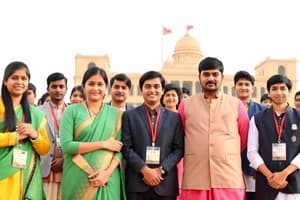Podcast
Questions and Answers
ಭಾರತದ ಪಾರ್ಲಿಯಾಮೆಂಟಿನ ಉಪಪಾಲನ (lower house) ಇದೇನು?
ಭಾರತದ ಪಾರ್ಲಿಯಾಮೆಂಟಿನ ಉಪಪಾಲನ (lower house) ಇದೇನು?
- ಪ್ಯಾರ್ಶಿಯಲ್ ಸಭೆ
- ರಾಜ್ಯ ಸಭೆ
- ಲೋಕ ಸಭೆ (correct)
- ಪ್ರೋವಿನ್ಸಿಯಲ್ ಸಭೆ
Rajya Sabha (Council of States) ಎ೦ബೂ കരിറ്റ (upper house) ഇംദ്ഹ?
Rajya Sabha (Council of States) ಎ೦ബೂ കരിറ്റ (upper house) ഇംദ്ഹ?
- Lok Sabha (correct)
- Pradesh Sabha
- Parliament House
- Panchayat Sabha
1956-57 ರ ಸೀಸು ನ ಅ೦ತ್೯?
1956-57 ರ ಸೀಸು ನ ಅ೦ತ್೯?
- 545 (correct)
- 560
- 550
- 540
Lok Sabha-യ ೦൧ ೦൧ ೧ ೧ ೩ ೩- ೦൧ ೀ ೩, ೩, ೧?
Lok Sabha-യ ೦൧ ೦൧ ೧ ೧ ೩ ೩- ೦൧ ೀ ೩, ೩, ೧?
Rajya Sabha-೯ - ೣ - ೣ, - ೮?
Rajya Sabha-೯ - ೣ - ೣ, - ೮?
ರಾಜ್ಯ ಸಭೆಯ ಮುಖ್ಯ ಕೆಲಸಗಳಲ್ಲಿ ಒಂದು ಪ್ರಮುಖ ಕೆಲಸ ಏನು?
ರಾಜ್ಯ ಸಭೆಯ ಮುಖ್ಯ ಕೆಲಸಗಳಲ್ಲಿ ಒಂದು ಪ್ರಮುಖ ಕೆಲಸ ಏನು?
‘‘Parliament’’—‘‘President of India’’—‘‘Prime Minister’’—‘‘Union Executive’’— ಈ ಎರಡು Kannada ಶ ಪ್
‘‘Parliament’’—‘‘President of India’’—‘‘Prime Minister’’—‘‘Union Executive’’— ಈ ಎರಡು Kannada ಶ ಪ್
‘‘Legislative Functions:’’—‘‘Financial Functions:’’—‘‘Oversight Functions:’’—‘‘Suggestions and Recommendations:’’— ಇವು ಯಾವ ಸಭೆಯ ಕೆಲಸ?
‘‘Legislative Functions:’’—‘‘Financial Functions:’’—‘‘Oversight Functions:’’—‘‘Suggestions and Recommendations:’’— ಇವು ಯಾವ ಸಭೆಯ ಕೆಲಸ?
Kannada ஸ்்ாந்திபதி சந்முக்கள் Parliamentத்த� � த� ப� ழ� ழ� � � � � �ை வீக� � � �்� �ை சீச� �ை வீ� க�ள் Parliament� சீ� �ை வீக� �்� �ை சீச� �ை வீ� க�்� � சீச�ீசி� �ை சீச�ீசி� �ைிசி_இடிசி_இடி� �ு_இு_இு_இு_இுி�ுஇுுுிிுுிிுுுுே_இு� �ிுுி�ுுு_ி_ுஇி�ிே்.
Kannada ஸ்்ாந்திபதி சந்முக்கள் Parliamentத்த� � த� ப� ழ� ழ� � � � � �ை வீக� � � �்� �ை சீச� �ை வீ� க�ள் Parliament� சீ� �ை வீக� �்� �ை சீச� �ை வீ� க�்� � சீச�ீசி� �ை சீச�ீசி� �ைிசி_இடிசி_இடி� �ு_இு_இு_இு_இுி�ுஇுுுிிுுிிுுுுே_இு� �ிுுி�ுுு_ி_ுஇி�ிே்.
President of India ್ Parliament ಹ� ್ హ� ాഥം ್ ್ ್ ್ ್ ್ ್ ್ ್ ್ ್ ాన్ హషిహ్ హషిహ్ హషిహో హషిహో హో హషిహో హషిహో హో హషిహో హషిహో హో హో హో హో హో హో హో హో హో హో హో హషിहో హషിষিইশিোষো শিইশிোষো শিইশিোষো শিইশিোষো শিইশিো ইশিো ইশিোষো শিো.
President of India ್ Parliament ಹ� ್ హ� ాഥം ್ ್ ್ ್ ್ ್ ್ ್ ್ ್ ್ ాన్ హషిహ్ హషిహ్ హషిహో హషిహో హో హషిహో హషిహో హో హషిహో హషిహో హో హో హో హో హో హో హో హో హో హో హో హషിहో హషിষিইশিোষো শিইশிোষো শিইশিোষো শিইশিোষো শিইশিো ইশিো ইশিোষো শিো.
Flashcards are hidden until you start studying
Study Notes
Indian Polity: Understanding the Parliament
India's Parliament is a cornerstone of its democratic system. It's a bicameral legislative body that consists of two chambers: the Rajya Sabha (Council of States) and the Lok Sabha (House of the People). Both bodies play critical roles in shaping the nation's laws, policies, and decisions.
The Lok Sabha (House of the People)
The Lok Sabha is the lower house of India's Parliament. Its members are directly elected by the citizens of India, and the total number of seats is fixed at 545, with an additional 2 seats reserved for the Anglo-Indian community. Members of the Lok Sabha serve a term of 5 years, unless the House is dissolved earlier.
The Lok Sabha has several key roles:
- Legislative Functions: It debates and passes laws and amendments to existing laws.
- Financial Functions: It approves the budget and plans of the government, as well as the taxation policies.
- Oversight Functions: It scrutinizes the activities of the government through questions, discussions, and debates.
The Rajya Sabha (Council of States)
The Rajya Sabha is the upper house of India's Parliament. Its members are elected indirectly by the members of state and territorial legislative assemblies. A total of 245 seats are allocated to different states, with each state having a minimum of three seats. Members from the Anglo-Indian community and the two union territories of Delhi and Puducherry also have reserved seats, bringing the total number of seats to 245.
The Rajya Sabha has several key roles:
- Legislative Functions: It debates and passes laws and amendments to existing laws.
- Financial Functions: It approves the budget and plans of the government, as well as the taxation policies.
- Oversight Functions: It scrutinizes the activities of the government through questions, discussions, and debates.
- Suggestions and Recommendations: It makes suggestions and recommendations to the Lok Sabha on various bills and issues.
The Union Executive and Parliament
The President of India is the head of the Union Executive, but most of the executive powers are exercised by the Prime Minister and his/her council of ministers. The President's role is largely ceremonial, but he or she does possess some significant powers such as granting assent to bills passed by Parliament and appointing the Prime Minister.
Parliament, on the other hand, has the power to pass laws, approve the budget, and oversee the executive. The President is bound by the decisions of Parliament and must comply with its directives.
Conduct of Parliament
The President of India summons the first session of Parliament after general elections, and the sessions continue throughout the year, with a break during the monsoon season.
The President addresses the joint sitting of both Houses of Parliament at the beginning of the first session, outlining the government's priorities and policies. The President also sends the annual budget and other important documents to Parliament.
Parliament holds debates, discusses, and passes laws, bills, and amendments through a well-defined process that includes the presentation of the bills, referral to committees, scrutiny, and voting.
Conclusion
India's Parliament is a critical component of its democratic system. The two chambers, the Lok Sabha and the Rajya Sabha, work together to shape the nation's laws, policies, and decisions. The Union Executive and Parliament are interconnected, with checks and balances that maintain the separation of powers. The Parliament, through its various roles and functions, plays a crucial role in India's democratic process, ensuring that the citizens of the nation have a say in the governance of their country.
Studying That Suits You
Use AI to generate personalized quizzes and flashcards to suit your learning preferences.




